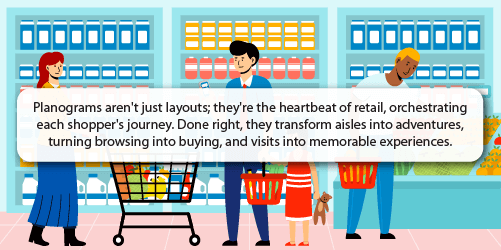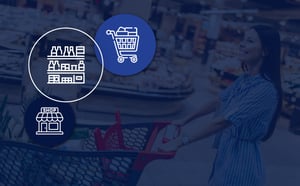Optimizing store flow is not just about shuffling shelves and hoping that it'll lead to a positive impact. There, we said it. Instead, it's a strategic imperative for retailers interested in providing a good customer experience. A well-designed flow propels sales and enhances the customer experience, while mistakes lead to the opposite - lost sales and a tarnished brand image.

Understanding why fine-tuning store flow with the help of planograms is pivotal; it's the blueprint guiding customers' journeys, influencing purchasing decisions at every turn. Effective planogram utilization ensures products are not only seen but experienced, weaving a narrative that can significantly boost basket sizes and fortify customer loyalty in an ever-evolving retail landscape.
The 'how' lies in leveraging shelf plans, crafted through planograms, to direct and delight customers. Strategic product placement and thoughtful navigation paths can transform browsing into buying, guiding customers effortlessly to their desires. As we delve deeper, we'll explore how retailers can apply planogram insights to perfect store flow, ensuring every aisle and display works harmoniously to elevate the shopping experience.

What impact does store flow have on the customer experience?
Designing an effective store flow in-store is not only a matter of creative or clever interior design. Instead, it's a strategic opportunity that allows retailers to influence the customer experience.
When discussing store flow, we're referring to the way customers navigate through the retail space. The shelf plan layout determines the sequence in which customers discover products and sections, the ease with which they can find what they're seeking, and ultimately, how pleasant and effortless the shopping journey is for them.
For example, grocery stores might place fresh produce at the entrance. Doing so offers visual appeal with vibrant colors and allows customers to follow a typical shopping pattern - most shoppers prefer to select fresh items first.
Following this, retailers can direct customers to the bakery, the deli, and then through the aisles, which are all arranged in a logical, findable manner. It isn't by chance, though. Instead, it's the result of careful planning using planograms to optimize store flow to match s how customers shop in-store.
On the other hand, poor store flow can lead to a disorganized shopping experience. If customers have to crisscross the store to find related items, or if they encounter a bottleneck in a particular section, it can lead to frustration and, in a worst-case scenario, may result in abandoned purchases.
Consider a customer entering a clothing store looking for a complete outfit. A well-considered store flow will group related items - tops near pants and accessories near both. This curated path not only facilitates the shopping process but also encourages additional purchases through cross-merchandising.
Retailers improve the overall shopping experience when they optimize the store flow. A smooth flow allows for easy navigation, which means that customers can find what they need quickly. But the benefits extend beyond just efficiency.
Good store flow also exposes shoppers to more products since they walk through the entire store rather than one or two sections.
For example, in bookstores, specific layouts guide the reader from bestsellers to staff picks, and finally, to niche genres, they may not have initially considered. This journey enables customers to stumble upon new items, sparking interest and potentially leading to unexpected purchases.
Moreover, a well-planned flow can significantly reduce the perceived shopping time. When customers enjoy a seamless shopping experience, time passes quickly. Retail giants like IKEA have mastered this with their one-way layout, which leads customers through a preset path that showcases the products in a home-like setting, enhancing both discovery and a sense of pace.
Store flow is a pivotal aspect of customer experience, extending beyond simple layout choices. It's about understanding customer behavior and designing a space that's not only easy to navigate but also conducive to discovery and satisfaction. Retailers that leverage planograms to optimize store flow know that they're investing in their customer's comfort and, by extension, their success.

What are typical store flow mistakes when designing planograms?
Planograms are the strategic backbone of retail space planning, but common errors in their design can significantly impede store flow, affecting sales and customer satisfaction. Recognizing and avoiding these pitfalls is essential for retailers to foster a positive shopping environment.
No logical shopping pathway
One frequent mistake is the lack of a clear, logical shopping pathway for customers. Stores that cram too many products into an aisle or have complex layouts can create confusion.
For example, a planogram neglecting customer shopping patterns within a category leads to frustration. They can't find what they want because it's different from where they expect it to be.
Poor product groupings
Another error is poor product grouping. When retailers place similar or complementary items across the store, it disrupts the shopping journey.
Customers expect to find related products in proximity - for example, placing coffee filters near coffee machines, not in separate aisles. It can frustrate customers, potentially leading to a loss in sales as shoppers may give up searching for the items they need.
Forgetting about adding impulse items
Neglecting the importance of impulse buys near the checkout area is a missed opportunity.
Planograms should incorporate space for impulse items to encourage additional purchases before checkout.
Retailers can often make the mistake of not refreshing these areas, causing regular customers to become blind to them over time. The strategic refreshment of planograms for these areas can enhance the customer's final moments in the store and boost sales.
Ignoring customer behavior analytics and data
Ignoring customer behavior analytics can also lead to a planogram that doesn’t reflect shopping patterns.
Retailers must use data collected from customer movements and purchases to refine their planograms, ensuring that the store layout aligns with how customers shop. When retailers design planograms (or outsource their creation to third parties) and don't use data, they get shelf plans that may not support the natural behavior of the shopper, resulting in a disjointed experience that can decrease satisfaction and sales.
The impact of these planogram design mistakes is significant. They can lead to a decrease in the time customers spend in the store, reduced basket sizes due to the difficulty in finding products, and, ultimately, a decline in repeat patronage.
By understanding and rectifying common planogram pitfalls, retailers can create a store flow that enhances the shopping experience, encourages sales, and fosters customer loyalty.

What planogram best practices must retailers consider to optimize store flow?
Optimizing store flow with planograms isn't only about product placement on the shelf. It's also about choreographing a customer's journey through the retail space.
Below are a few best practices for retailers to remember when designing or adjusting their planograms for a smooth store flow.
Design for easy accessibility
Ensure that the planogram provides clear sightlines to important categories and products. That means choosing appropriate layouts, including merchandising strategies and techniques.
Also, avoid high shelving that makes it harder for shoppers to reach products. IKEA is an excellent example of visibility and accessibility; despite its size, clear signage and a winding path lead customers through various sections, making products easy to find and reach.
Group related products intelligently
Strategically group related products to create a logical shopping flow. Place complementary items near each other to encourage additional purchases.
For example, placing accessories next to smartphones in electronics stores prompts customers to consider products they may not have initially intended to buy.
Incorporate flexibility for seasonal changes
Retailers must adapt their planograms for seasonal changes. It may mean shifting the flow to highlight seasonal goods.
For example, department stores rotate layouts to feature back-to-school supplies in August and holiday decorations in late autumn.
Test and refine based on feedback
After implementing a new planogram, gather feedback from customers and staff. Observe how customers interact with the new layout and make adjustments accordingly. A/B testing different layouts can provide valuable insights into the most effective store flow.
By following these best practices, retailers can create a planogram that not only showcases their products effectively but also fosters an intuitive and enjoyable shopping experience that can lead to increased sales and customer loyalty.

The role of tools and technology in enhancing store flow
Given the increased competition within the retail industry, leveraging technology to enhance store flow has become imperative. Sophisticated tools and software provide retailers with insights into how to design store layouts for maximum efficiency and enhanced customer satisfaction.
Planogram software solutions
Advanced planogram software allows retailers to create visual representations of their store's layout and shelf space. This software often includes features for space planning and product placement that are grounded in sales data analytics.
DotActiv, for example, provides planogram software and services to South African retailers like Makro, Dis-Chem, Ultra Liquors, and others to create planograms and ensure that they utilize their space efficiently and drive sales.
Data analytics and customer movement
The integration of data analytics in planogram software allows retailers to understand and predict customer movement within the store. Retailers can use heat mapping tools, which track customer movements through the store, identifying high-traffic areas and dwell points.
Retailers can translate these insights into planogram adjustments that direct flow and increase exposure to targeted products. Companies like WHSmith and InMotion use such data to redesign store layouts, leading to an increase in customer satisfaction by reducing congestion and improving the shopping experience.
RFID and inventory management
Radio Frequency Identification (RFID) technology helps retailers keep tabs on inventory on the sales floor and in the backroom, allowing for real-time planogram updates.
When products are running low or are out of stock, the planogram can be adjusted to fill the gaps, thus maintaining the optimal store flow and visual appeal.
Apparel retailers, such as Zara, use RFID to ensure their hottest items are always in stock and displayed prominently, guiding customers through the store to these areas.
Mobile planogram access and updates
With mobile technology, store managers and employees can access and update planograms on the go. This flexibility means that they can make changes in store flow in response to real-time sales data or inventory changes.
For example, Home Depot employees use handheld devices to manage inventory and assist customers in navigating the store efficiently. Activ8 integrates with DotActiv, enabling the software to send new and updated planograms to store users for implementation. Store managers can also provide immediate feedback and proof of in-store implementation.
Predictive analytics for future planning
Predictive analytics can forecast future buying trends and customer behaviors, empowering retailers to proactively adjust their planograms proactively. By analyzing past and current data, retailers can predict how changes in store flow will affect customer behavior.
Nordstrom, for example, uses predictive analytics to personalize the shopping experience, which includes optimizing the store layout for anticipated customer paths.
Conclusion
Planograms have the power to influence store flow and elevate the customer experience. It thus makes sense that retailers need to do everything in their power to ensure they effectively utilize planograms. Don't wait to optimize your retail space. Download your free 14-day trial now and witness the immediate benefits for yourself.


